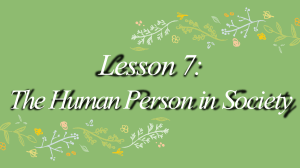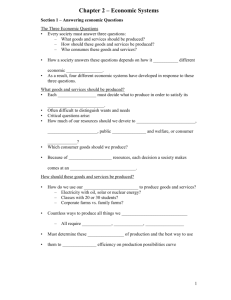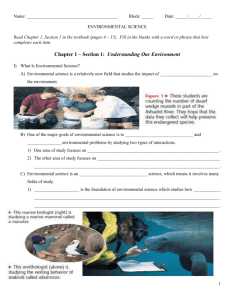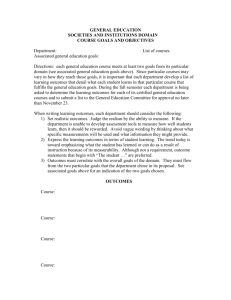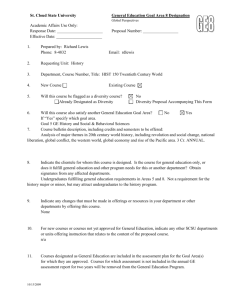Introductorysociologynotes
advertisement
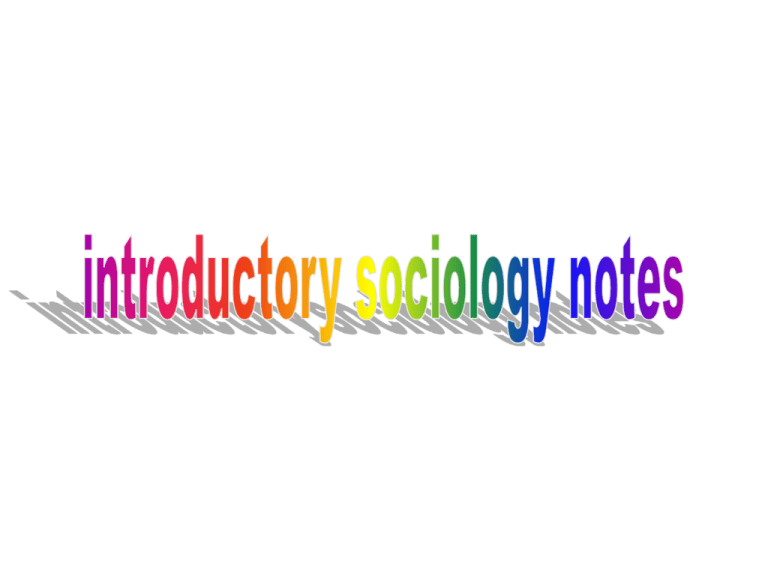
Correlation – relationships among variables – positive or negative Spurious Correlations – variables that appear to have a relationship but have no common causation Conducting Sociological Research 4 main methods Research Methods Ethnographies Cross-Cultural Research SURVEYS • Standardized questionnaires and interviews that gather information from large population samples • May measure public opinion and societal assumptions • Data used to predict cultural patterns • Especially useful to measure issues and events that cannot otherwise be evaluated EXPERIMENTS • Most effective method to establish Cause and Effect relationships • Test hypothesis by using dependent and independent variables • Can be done in a Lab (Latane’s “social loafing” - the larger the group the more one tends to be lazy and rely more on the group) • Can be done in the field (Rich Voszkul’s “work production” – painted walls pink , less time in the restroom ETHNOGRAPHIES • Social observations • Detailed case studies over extended periods of time • Eye witness accounts of specific social lifestyles • OVERT participation observation – observational group knows research is going on • COVERT participation observation – sociologists enter social worlds without identifying themselves to their research projects Research Data • Validity is the degree to which a study measures what it is attempting to represent – Strong correlations yield valid data • Reliability is the degree to which research data remains accurate (or valid) after being repeated CROSS-CULTURAL • Comparative research examining 2 or more different cultures • Goal is to find relationships and common ground • Examine differences and ways to repair relationships • Examine comparative problems as part of a global system (i.e. globalization) Society – group of people who share a culture and territory Culture – shared norms, values, beliefs, knowledge, symbols, and communication among members of a group Homogeneous vs Pluralistic Society • Homogeneous Society – culture of a single dominate group with very few subcultures • Pluralistic Society – culture composed of many (often diverse) social groups, subcultures, and countercultures Social Structure • Patterns of social relationships (marriage, employment) • Hierarchy of governing positions (president, tribal chief) • Number of people within groups (average family size) Social Institutions Standardized organizations Members can be voluntary or involuntary Optional enrollment or assigned Social Action • Human behavior is dependent upon actions within a group….an individual’s role within their society Transformation and Evolution of Societies • Phase One - Hunting and Gathering • Phase Two - Agrarian Societies • Phase Three - Industrial Societies • Phase Four – Post - Industrial Phase 1 Hunting/Gathering • • • • • Primitive technology Small societies of clans and tribes Seasonal migrations (food availability) Very few social divisions Basic needs, food shared, little material wealth • age=social prestige Modern H&G’s found in Central South – America (Pygmy’s), Africa (San tribes), and in the Australian Outback (Aborigines) H&G continued • Horticultural/Agricultural Revolution • Domestication of plants = fields • Use of tools to cultivate and harvest food • Pastoral Revolution Domestication of animals = livestock • Raising and breeding of animals for food As a result: permanent settlements developed and food surpluses allowed population growth! • Agricultural Revolution – • • • • advancements in animal and plant domestication Stable and Renewable food supply Farms led to permanent settlements, therefore civilizations Food supporting larger populations Key invention ! Steel plow Phase 2 Agrarian Societies • Family farms • Farming technology = food surplus • Diversified labor force (i.e. craftsmen, blacksmiths, merchants, soldiers ) since all people were not foraging for food • Centers of commerce – agriculturally based • Cities where ideas, good, technologies, services, and culture were exchanged • Diversified and specialized roles (within new religious institutions and kingships) Agrarian Society continued Industrial Revolution Steam Engine! Reliance on animals and humans to run mills, plow fields, pump water Fuel powered combustible engines Productions is faster and more efficient Agrarian society ends with people becoming employed in factories and on farms Phase 3 Industrial Society • More work in less time = efficiency = mass production • Factory jobs = urban migration • Gender roles appear for the first time • cities, social roles and culture become more diversified and specialized • Social inequality evident (rise of “Middle Class” and Marx displays class conflict theories Industrial Societies continued • Information/Computer Revolution!!!! –Microchip processors –Computers make all forms of commerce efficient –Global communication making information a most valuable product Phase 4 Postindustrial Society • Current U.S. phase • From manufacturing economy to a service economy • Rise of Corporate CEO’s • Current PI societies = U.S., Western Europe, and Japan with more joining Material culture: art, architecture, jewelry, weaponds, machinery, clothing, food, music, etc. societal characteristics shared by all members within the group- passed down from generations Nonmaterial culture: shared knowledge (ed. System), language, beliefs and values (religion), social norms and behaviors Ethnocentrism is the feeling that your culture is superior to all others and uses their standards to measure and compare other societies Social values are standards by which people define what is desirable or undesirable, good or bad, beautiful or ugly Social Norms are expectations or rules of behavior that develop from generations of accepted values Taboo = social norms that are so strong that people are shunned, banished, or executed if violated • “mini-cultures” within a dominant culture – Segregation can be self-imposed or forcibly removed – Subcultures are usually ethnic divisions or religious – Examples of American subcultures… • Amish and Mennoties, China Town, Little Italy Social Stratification • Divisions within a society usually based upon relative power, property wealth, and prestige – Can be applied to nations on a global scale and/or people and subgroups within a nation – Foundation of social class systems Social Mobility is the degree to which people can move up or down the social class ladder A clique is a small cluster of people within a larger social group who choose to interact exclusively among themselves are…. • Groups with values and norms that directly oppose the dominant culture • Examples of American counter cultures: – “Rebel Generation” of the 1950’s – “Hippie” Movement of the 1960”s-1970”s
